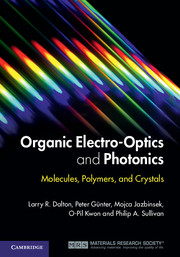Book contents
- Frontmatter
- Dedication
- Contents
- 1 Introduction
- 2 Nonlinear optical effects
- 3 Electro-optic effects
- 4 Molecular nonlinear optics
- 5 Acentric self-assembled films
- 6 Crystalline materials
- 7 Electrically poled organic materials and thermo-optic materials
- 8 Overview of applications
- 9 Organic electro-optic waveguides, switches, and modulators
- 10 Nonlinear optical infrared and terahertz frequency conversion
- 11 Photorefractive effect and materials
- 12 Conclusions and future prospects
- Index
- References
11 - Photorefractive effect and materials
Published online by Cambridge University Press: 05 August 2015
- Frontmatter
- Dedication
- Contents
- 1 Introduction
- 2 Nonlinear optical effects
- 3 Electro-optic effects
- 4 Molecular nonlinear optics
- 5 Acentric self-assembled films
- 6 Crystalline materials
- 7 Electrically poled organic materials and thermo-optic materials
- 8 Overview of applications
- 9 Organic electro-optic waveguides, switches, and modulators
- 10 Nonlinear optical infrared and terahertz frequency conversion
- 11 Photorefractive effect and materials
- 12 Conclusions and future prospects
- Index
- References
Summary
While literally the word photorefraction may describe all kinds of photo-induced changes of the refractive index of a material and therefore any photo-induced phase grating would belong to this category, it has become customary in the literature to consider only a smaller class of materials as being photorefractive. These materials possess two important properties: they are photoconductive and exhibit an electro-optic effect. Photoconductivity ensures charge transport, resulting in the creation of a space-charge distribution under inhomogeneous illumination. The electro-optic effect translates the internal electric fields induced by the inhomogeneous space-charges into a modulation of the material refractive index. This is the main mechanism for photorefraction in inorganic and organic crystals [1]. In polymers and liquid crystals, the concept of photorefraction has been expanded to include refractive index changes governed by a field-assisted molecular reorientation of the chromophores. The photorefractive effect is also distinguished from many other mechanisms leading to optically induced refractive index gratings by the fact that it is an intrinsically non-local effect, in the sense that the maximum refractive index change does not need to occur at the spatial locations where the light intensity is largest.
In the strict sense mentioned above, the photorefractive effect was first observed in the mid-1960s by Ashkin and co-workers [2]. They found that intense laser radiation focused on ferroelectric LiNbO3 and LiTaO3 crystals induced semi-permanent index changes. This phenomenon was unwanted for their purposes, and therefore they referred to it as “optical damage”. However, the potential of this new effect for use in high-density optical storage of data was soon realized by Chen and co-workers [3]. The effect later became known as the photorefractive effect, and it is understood as a modulated refractive index change. Although the photorefractive effect was first discovered in inorganic-ferroelectric materials, in the past few years highly polarizable and photoconductive organic crystals and polymeric materials with extended π-electron systems have presented themselves as possible candidates for photorefractive applications.
The photorefractive process, which culminates with the formation of the phase grating, is described by the mechanisms shown in the schematic diagram of Fig. 11.1. The three most important properties that a material must fulfill are depicted in the figure in the shaded boxes: optical absorption, charge transport, and electro-optic effect or field-assisted molecular reorientation.
- Type
- Chapter
- Information
- Organic Electro-Optics and PhotonicsMolecules, Polymers and Crystals, pp. 250 - 281Publisher: Cambridge University PressPrint publication year: 2015



